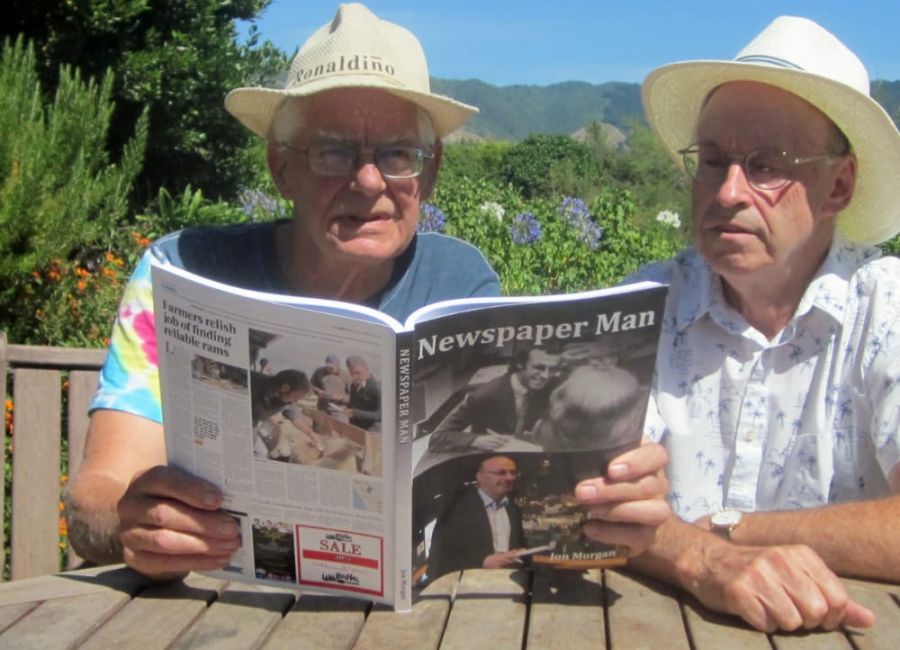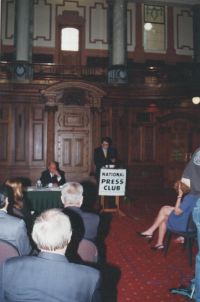Newspaperman Jon Morgan pictured at the book launch with fellow Fairfax era colleague Richard Woodd
Jon Morgan became a newspaper reporter at the age of 16 in 1966. It was the high noon of print with 42 daily newspapers nationwide. Zig zagging his way mainly through what was to become the Fairfax then Stuff chain he contrived to remain on a payroll until 2018. In maintaining this half century trapeze act Morgan looks back at what can be seen now as a gradually crumbling print news industry.
He appears to have kept employed by keeping constantly flexible and grasping whatever opportunity or story came his way and following it wherever it led him.
Perceiving that times they really were a-changing we follow Morgan as he gradually eases himself away from the assignment book and onto the specialist track as an agricultural reporter a manoeuvre that sustained him through to his final working days. He additionally armoured himself against the increasingly lethal arrows of outrageous fortune by embellishing himself with a high profile in his chosen agrarian field.
A surprise to many print practitioners will be the immense number of awards adorning the field of agricultural journalism in general and Morgan in particular. The by now roving rural reporter enters his name into seemingly every one of these and appears to have emerged as a consistent victor becoming in the process an agricultural sector statesman officiating in show judging among other rural rituals.
Morgan we can see now entered journalism in its last few years as a bona fide blue collar calling prior to admission to the trade being taken over by the universities. His description of the final days of on-the-job journeyman training and those who administered it should alone ensure his book a place in any official archive of industrial apprenticeship history.
The presentation of this book is of short and sharp lavishly illustrated pieces centred on a march past of personalities. These are divided between sketches and vignettes of his own vintage colleagues and of his raw material which was mainly the farmers he wrote about.
Time has not mellowed his memories and quite a few of these brisk appraisals are caustic and deliberately incautious. Neither does Morgan spare himself. He routinely scolds himself for an enduring attitude of frivolity. Still, he seems to have kept his feet on the ground, and in pretty much the same patch the North Island’s Central Districts.
As the outline of his own end game begins to loom spectrally on the horizon Morgan becomes progressively more distressed at the way in which his employers start to abandon farm coverage. His impatience accelerates as his bosses then segue into actually attacking farmers for muddying the cherished fashionable urban cultural ideals now taking over editorial direction..
Morgan in vain sought to point out that it was the people in the provinces and notably farmer subscribers who still wanted their information in print rather than on a screen, and by the way supplied the wealth that the metropolitan newspapers depended on.
Nobody it seems listened. The newspapers stepped up their critiques of what they saw and portrayed as the brutish ways of farmers. A still greater share of revenue from still profitable print versions poured into a variety of speculative electronic alternatives.
Jon Morgan seems never to have been lured by the siren song of the public relations world. He entered the industry just as television arrived, yet he stuck with print.
He floats the perplexing and largely unvoiced issue of why so many stories in the internet era give the impression of being bottomless mixes of opinion and conjecture the meaning of which readers are left to work out for themselves and solve rather like crossword puzzles.
One is left with an impression that whatever the future holds for the energetic yet now out-to-graze newspaperman it will not be at a Media Studies establishment or at a J School.

















